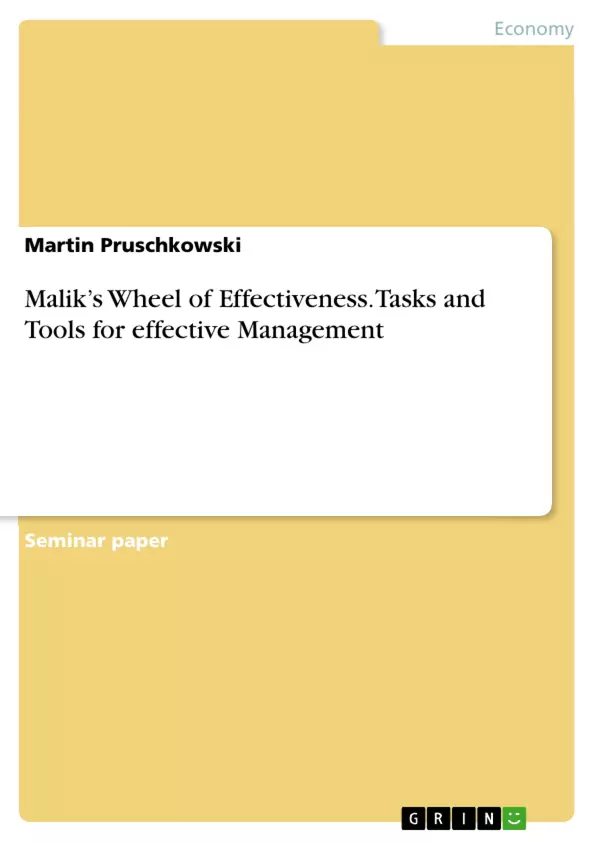Until the 1970s the view was widespread, management could be neither teach nor learn; it was more of an art to which one would be born. A successful manager should have special character traits and personality characteristics. In practice, this opinion has, however, not enforced. Peter F. Drucker and Fredmund Malik have introduced a new picture of effective management. Due to the fact, the basic requirements of effective management are independent of industry, country and culture they represent the perceptive that effective management can be learned by practicing and using the right tasks and tools. Therefore, Malik summarized all important elements like principles, responsibility, task and tool of effective management in one system named Standard Model of Effectiveness a.k.a. The Wheel of Effectiveness. This model serves as a guideline for manager for effective management. Figure 1 shows the Standard Model of Effectiveness by Malik.
Inhaltsverzeichnis (Table of Contents)
- Introduction
- Objective
- Structure and methods
- Short Biography of Fredmund Malik
- Tasks of effective Management
- Providing objectives
- Organizing
- Decision making
- Monitoring
- Developing people
- Tools of effective Management
- Meetings
- Report and Written Communication
- Job Design & Assignment Control
- Personal Working Method
- Budget and Budgeting
- Performance Appraisal
- Systematic Abandonment
- Conclusion
Zielsetzung und Themenschwerpunkte (Objectives and Key Themes)
This assignment aims to delve deeply into the tasks and tools of Malik's Wheel of Effectiveness, analyzing their completeness, validity, and applicability in real-world scenarios.
- The essential tasks and tools for effective management according to Malik's Wheel of Effectiveness.
- The importance of providing clear objectives and aligning them with individual goals.
- The critical role of organization and structure in achieving effectiveness.
- The complexities of decision-making, including the need for careful consideration and participation.
- The significance of continuous monitoring and feedback mechanisms in driving performance.
Zusammenfassung der Kapitel (Chapter Summaries)
The first chapter introduces Malik's Wheel of Effectiveness, presenting its core principles and the underlying philosophy of effective management. It also provides a brief biography of Fredmund Malik and his contributions to the field of management.
Chapter 2 focuses on the five core management tasks identified by Malik: providing objectives, organizing, decision-making, monitoring, and developing people. Each task is discussed in detail, highlighting its significance and practical applications through various examples.
Chapter 3 explores seven key tools for effective leadership: meetings, report and written communication, job design & assignment control, personal working method, budget and budgeting, performance appraisal, and systematic abandonment. The chapter explains each tool in depth, providing illustrative examples of effective leaders who have successfully employed these practices.
Schlüsselwörter (Keywords)
The main keywords and focus topics of this work include effective management, Malik's Wheel of Effectiveness, core management tasks, tools for effective leadership, decision-making, monitoring, performance appraisal, systematic abandonment, and the role of the manager.
- Quote paper
- Martin Pruschkowski (Author), 2014, Malik’s Wheel of Effectiveness. Tasks and Tools for effective Management, Munich, GRIN Verlag, https://www.hausarbeiten.de/document/432957


